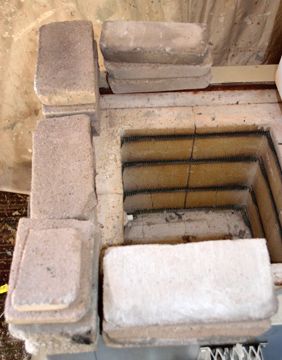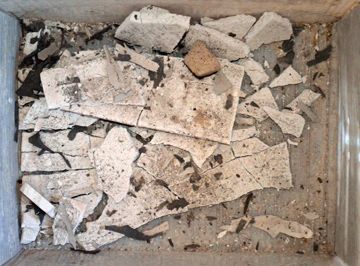I ventured into pyrolysis of biomass last week.
I filled up my retort with animal fat, veg oil and sawdust. I heated it up to 400C and ran it for about 5 hours. I got about 20 litres of liquid bio oil and a lot of gas( 42 kg of feedstock) The gas burned bright blue just like propane. The bio oil is the most evil smelling fuel I have ever encountered. My eyes start to sting as soon as I open the container. It is black with a layer of watery sludge in the bottom. It has about the same viscosity as diesel.
The retort was still half full of tar when opened with the same acrid blinding smell. It was a horrible job to clean it out. Even my next batch of nice clean plastic was contaminated by it until about halfway through.
I believe that the horrible smell is propenal (acrolein) which is produced by the thermal decomposition of the glycerol content of oils and fats.
The yield was so low, the fuel so nasty and the residue so troublesome that I wont be trying that again.
Announcement
Collapse
No announcement yet.
How to turn plastic waste into diesel fuel cheaply
Collapse
X
-
Organic waste to fuel ???
Do you know if there is a method/unit for converting organic waste (banana peel, aple leftovers, dead flowers and any other kind of fruit or plant organic waste ) into something usefull.
An year ago I started reading the forum I got to the half point but i dont remeber someone talking about it. Then I had to travel and I stopped following the thread, now I see that it doubled its pages. So if there is already a post regarding this please redirect.
Thank you.
Leave a comment:
-
I happen to agree. It looked like all media-hype to me to.Originally posted by imakebiodiesel View PostFrom the description they seem to be gasifying the plastic and then using a technique similar to the Fischer Trophsc process to turn the gas back into liquid. So much energy would be required to do this that it would yield very little if any fuel in the end. When the only illustrations are " artists impressions" I begin to smell a rat, or rather a scam.
Leave a comment:
-
From the description they seem to be gasifying the plastic and then using a technique similar to the Fischer Trophsc process to turn the gas back into liquid. So much energy would be required to do this that it would yield very little if any fuel in the end. When the only illustrations are " artists impressions" I begin to smell a rat, or rather a scam.
Leave a comment:
-
I'm not sure why they run their process at 900C. For plastic pyrolysis I notice far more gases being produced as the temperature gets above 400COriginally posted by simonus View PostHi everybody,
I'm new to this forum, just found out about it yesterday evening. I havent read all of the pages but I like the general idea.(how cool is it to make your own fuel!!)
I was at a military convention a few weeks ago and found out about this :
Blue Green Energy - Homepage
been talking to the guy there for about an hour and got really interrested but he wouldnt tell me anything about how the process works.
So I did some research and found out about pyrolysis and via google found this forum!
What i found out was that the system uses "fast pyrolysis", at 900 C and a fischer-tropsch like converter to make fuels like diesel or kerosine(the american army uses jp-8 kerosine but most of the european armies use diesel fuel) and it produces the same amount of distilled water. It can be fed by any type of waste(biomass, plastics or a combination) because it is shred really small.
I'm more interrested in the biomass converter personally, but you have to start somewhere and you guys have made awesome progress! I'll be reading up on all you have done in the next couple of days and then I'll try to design a machine of my own(prefferebly biomass fast pyrolysis).
I just want to say to all, awesome work and thinking.
keep it up!
Simonus
In addition, it takes way more energy to get the retort up to that temperature and then maintain it. The insulation would need to be excellent and would be more expensive since fiberglass won't work well.
If they're running it that hot it sounds like they need to find a suitable catalyst.
Leave a comment:
-
Hi!
Hi everybody,
I'm new to this forum, just found out about it yesterday evening. I havent read all of the pages but I like the general idea.(how cool is it to make your own fuel!!)
I was at a military convention a few weeks ago and found out about this :
Blue Green Energy - Homepage
been talking to the guy there for about an hour and got really interrested but he wouldnt tell me anything about how the process works.
So I did some research and found out about pyrolysis and via google found this forum!
What i found out was that the system uses "fast pyrolysis", at 900 C and a fischer-tropsch like converter to make fuels like diesel or kerosine(the american army uses jp-8 kerosine but most of the european armies use diesel fuel) and it produces the same amount of distilled water. It can be fed by any type of waste(biomass, plastics or a combination) because it is shred really small.
I'm more interrested in the biomass converter personally, but you have to start somewhere and you guys have made awesome progress! I'll be reading up on all you have done in the next couple of days and then I'll try to design a machine of my own(prefferebly biomass fast pyrolysis).
I just want to say to all, awesome work and thinking.
keep it up!
Simonus
Leave a comment:
-
Since my forum is still down, and this forum is quiet, then I thought I would report my recent experiments experiments with insulation for pyrolysis temperatures.
Yesterday I opened my kiln from a day-long firing to 800F to test some more firebricks and a piece of sheet rock, to see how they would fair.

My 50-50 ash-plaster+ sodium silicate bricks came out 100% good, and fairly light at 1lb 10oz (730gm), and they made it up to 400c.

The sheet rock failed.
Leave a comment:
-
All's quiet on the forum so I thought I'd mention there's a few updates to my blog re progress on the newest iteration of turk-retort. Various revised posts & pages show developments.
Much of the early experimental prototype articles have been condensed to the archive page.
Hope something there is of help.
Leave a comment:
-
Hi Excalibur, yes the Beyond Biodiesel forum is down. I have sent my web host a request to fix it, but he might be on vacation. I am trying to fix it myself, but I have not had any success yet. I am also looking into alternatives.Originally posted by Excalibur View PostThanks for advising. I'd heard of it happening somewhere. The fact that a small amount has done this is surprising. Annoying to have to reprocess it though.
BB, I see the BB website has been down for some days. Is it temporary? Says: Maintenance Mode...
Thanks for your concern.Last edited by Beyond Biodiesel; 06-04-2013, 12:14 PM.
Leave a comment:
-
Thanks for advising. I'd heard of it happening somewhere. The fact that a small amount has done this is surprising. Annoying to have to reprocess it though.
BB, I see the BB website has been down for some days. Is it temporary? Says: Maintenance Mode...
Leave a comment:
-
Thanks for reporting your findings. Over boiling is certainly an issue, but I did not know that it could cause cracked fuel to re-polymerize. Very interesting.Originally posted by imakebiodiesel View PostJust a note of caution about over boiling.
I was doing a batch yesterday in my new larger processor. I had collected 7 litres of nice clear fuel and I got a bit over enthusiastic and allowed the temp to rise to 425C while the retort was still nearly full. Hot waxy liquid began to spew out of the fuel outlet pipe. I turned off the heat and got the process under control but by that time about a litre of waxy stuff had contaminated the 7 litres. I changed the container and finished processing the batch.
Over a period of about 2 hours the whole 8 litres turned into solid wax! There would seem to be a chain reaction or radical reaction at work here. Even a small amount of semicracked wax can ruin a larger amount of good liquid fuel.
Leave a comment:
-
Just a note of caution about over boiling.
I was doing a batch yesterday in my new larger processor. I had collected 7 litres of nice clear fuel and I got a bit over enthusiastic and allowed the temp to rise to 425C while the retort was still nearly full. Hot waxy liquid began to spew out of the fuel outlet pipe. I turned off the heat and got the process under control but by that time about a litre of waxy stuff had contaminated the 7 litres. I changed the container and finished processing the batch.
Over a period of about 2 hours the whole 8 litres turned into solid wax! There would seem to be a chain reaction or radical reaction at work here. Even a small amount of semicracked wax can ruin a larger amount of good liquid fuel.
Leave a comment:
-
"...but what the hell, free fuel..."




This is one of my favourites (wood gas truck) :https://www.youtube.com/watch?v=aRbYiP0cJmg
Originally posted by imakebiodiesel View PostHere is the solution to gas storage and usage. Wouldnt do a lot for the streamlining, but what the hell, free fuel. Unfortunately maximum range is about 10 miles.

Uploaded with ImageShack.us
Leave a comment:
-
Here is the solution to gas storage and usage. Wouldnt do a lot for the streamlining, but what the hell, free fuel. Unfortunately maximum range is about 10 miles.

Uploaded with ImageShack.us
Leave a comment:
-
Thanks!Originally posted by imakebiodiesel View PostAn added advantage of using a wine box is that you get the pleasure of emptying the box first.
I no longer use the pressure relief valves shown in earlier pictures for exactly the reason you mentioned. The plastic parts of the valve would not withstand hot gases passing through the valve. The valve I now use is all brass and stainless steel and ca be adjusted from .5 to 15bar. Here is a link.
WL Hamilton Bronze, 0-35 Bar Adjustable Pressure Relief Valve - Pressure Relief Valve, Adjustable 0-35 Bar, Bronze Bodied - Valves - Pressure Relief - Valves (All Types) - Oilybits.com - The U.K's Premier Bio Fuel Equipment Superstore
Leave a comment:
Leave a comment: